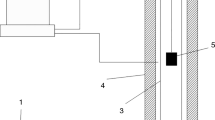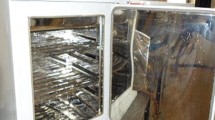Abstract
The present study investigated the drying kinetics of taro slices precooked in different medium viz water (WC), steam (SC) and Lemon Solution (LC) and dried at different microwave power 360, 540 and 720 W. Drying curves of all precooked slices at all microwave powers showed falling rate period along with a very short accelerating period at the beginning of the drying. At all microwave powers, higher drying rate was observed for LC slices as compared to WC and SC slices. To select a suitable drying curve, seven thin-layer drying models were fitted to the experimental data. The data revealed that the Page model was most adequate in describing the microwave drying behavior of taro slices precooked in different medium. The highest effective moisture diffusivity value of 2.11 × 10−8 m2/s was obtained for LC samples while the lowest 0.83 × 10−8 m2/s was obtained for WC taro slices. The activation energy (E a ) of LC taro slices was lower than the E a of WC and SC taro slices.





Similar content being viewed by others
References
A.S. Huang, C.A. Titchenal, B.A. Meilleur, Nutrient composition of Hawaiian taro corms and breadfruit. J. Food Compos. Anal. 13, 859–864 (2000)
P. Kaushal, V. Kumar, H.K. Sharma, Comparative study of physicochemical, functional, antinutritional and pasting properties of taro (Colocasia esculenta), rice (Oryza sativa) flour, pigeonpea (Cajanus cajan) flour and their blends. LWT Food Sci. Technol. 48, 59–68 (2012)
Aboubakar, Y.N. Njintang, J. Scher, C.M.F. Mbofung, Physicochemical, thermal properties and micro structure of six varieties of taro (Colocasia esculenta L. Schott) flours and starches. J. Food Eng. 86(2), 294–305 (2008)
M. Kaur, P. Kaushal, K.S. Sandhu, Studies on physicochemical and pasting properties of taro (Colocasia esculenta L.) flour in comparison with a cereal, tuber and legume flour. J. Food Sci. Technol. 48, 1–7 (2011)
M.S. Ammar, A.E. Hegazy, S.H. Bedeir, Using of taro flour as partial substitute of wheat flour in bread making. World J. Dairy Food Sci. 4(2), 94–99 (2009)
C.A.I. Emmanuel, N.C. Osuchukwu, L. Oshiele, Functional and sensory properties of wheat (Aestium triticium) and taro flour (Colocasia esculenta) composite bread. Afr. J. Food Sci. 4(5), 248–253 (2010)
M. Himeda, Y.N. Njintang, E. Fombang, B. Facho, P. Kitissou, C.M.F. Mbofung, J. Scher, Chemical composition, functional andsensory characteristics of wheat-taro composite flours and biscuits. J. Food Sci. Technol. 51(9), 1893–1901 (2014)
V. Kumar, H.K. Sharma, P. Kaushal, K. Singh, Optimization of taro-wheat composite flour cake using Taguchi technique. Food Meas. 9(1), 35–51 (2015)
W.K. Nip, C.S. Whitaker, D. Vargo, Application of taro flour in cookie formulations. Int. J. Food Sci. Technol. 29, 463–468 (1994)
P. Kaushal, H.K. Sharma, Effect of Incorporating Taro (Colocasia esculenta), Rice (Oryza sativa), and Pigeon Pea (Cajanus cajan) Flour Blends on Noodle Properties. Int. J. Food Prop. 17(4), 765–781 (2014)
Y.N. Njintang, C.M.F. Mbofung, G.K. Moates, Functional properties of five varieties of taro flour, and relationship to creep recovery and sensory characteristics of achu (taro based paste). J. Food Eng. 82, 114–120 (2007)
V. Kumar, H.K. Sharma, K. Singh, R.P. Singh, Optimization of process parameters for the production of taro chips using RSM with fuzzy modeling. Food Meas. 9(3), 400–413 (2015)
T.S. Workneh, V. Raghavan, Y. Gariepy, Microwave assisted hot air ventilation drying of tomato slices, in International Conference on Food Engineering and Biotechnology IPCBEE, vol 9 (IACSIT Press, Singapore 2011)
M. Zhang, J. Tang, A.S. Mujumdar, S. Wang, Trends in microwave related drying of fruits and vegetables. Trends Food Sci. Technol. 17, 524–534 (2006)
U. Erle, H. Shubert, Combined osmotic and microwave-vacuum dehydration of apples and strawberries. J. Food Eng. 49(2), 193–199 (2001)
S. Mishra, V. Kumar, H.K. Sharma, Preparation and modeling of potato powder by thin layer microwave drying. Potato J. 39(2), 145–154 (2012)
J. Wang, Y.S. Xiong, Y. Yu, Microwave drying characteristics of potato and the effect of different microwave powers on the dried quality of potato. Eur. Food Res. Technol. 219, 500–506 (2004)
A. Harish, M. Rashmi, T.P. Krishna Murthy, B.M. Blessy, S. Ananda, Mathematical modeling of thin layer microwave drying kinetics of elephant foot yam (Amorphophallus paeoniifolius). Int. Food Res. J. 21(3), 1081–1087 (2014)
M. Bhattacharya, P.P. Srivastav, H.N. Mishra, Thin-layer modeling of convective and microwave-convective drying of oyster mushroom (Pleurotus ostreatus). J. Food Sci. Technol. 52(4), 2013–2022 (2015)
H. Darvishi, A. Banakar, M. Zarein, Mathematical modeling and thin layer drying kinetics of carrot slices. Global J. Sci. Front. Res. Math. Decis. Sci. 12(7), 57–64 (2012)
S. Celen, K. Kahveci, Microwave drying behaviour of apple slices. J. Process Mech. Eng. 227(4), 264–272 (2013)
J. Wang, J.S. Wang, Y. Yu, Microwave drying characteristics and dried quality of pumpkin. Int. J. Food Sci. Technol. 42, 148–156 (2007)
Aboubakar, Y.N. Njintang, J. Scher, C.M.F. Mbofung, Texture, microstructure and physicochemical characteristics of taro (Colocasia esculenta) as influenced by cooking conditions. J. Food Eng. 91, 373–379 (2009)
D.M. Bruce, Exposed-layer barley drying: three models fitted to new data up to 150 °C. J. Agric. Eng. Res. 32, 337–348 (1985)
G.E. Page, Factors influencing the maximum rates of air drying shelled corn in thin layers, M.S. Thesis, Department of Mechanical Engineering, Purdue University, Purdue 1949
S.M. Henderson, S. Pabis, Grain drying theory II: temperature effects on drying coefficients. J. Agric. Eng. Res. 6, 169–174 (1961)
C.Y. Wang, R.P. Singh, Use of variable equilibrium moisture content in modelling rice drying. Trans. ASAE 11, 668–672 (1978)
L.M. Diamante, P.A. Munro, Mathematical modelling of hot air drying of sweet potato slices. Int. J. Food Sci. Technol. 26(1), 99–109 (1991)
I.T. Togrul, D. Pehlivan, Mathematical modeling of solar drying of apricots in thin layers. J. Food Eng. 55, 209–216 (2002)
L.R. Verma, R.A. Bucklin, J.B. Endan, F.T. Wratten, Effects of drying air parameters on rice drying models. Trans. ASAE 28, 296–301 (1985)
J. Crank, The mathematics of diffusion (Clarendon Press, Oxford, 1975)
O. Belma, D. Gokce, Thin layer drying characteristics and modelling of mint leaves undergoing microwave treatment. J. Food Eng. 83, 541–549 (2007)
G. Dadali, D.K. Apar, B. Ozbek, Microwave drying kinetics of okra. Drying Technol. 25(5), 917–924 (2007)
J.I. Mate, C. Quartaert, G. Meerdink, K. Van’t Riet, Effect of blanching on structural quality of dried potato slices. J. Agric. Food Chem. 46, 676–681 (1998)
H.W. Xiao, X.D. Yao, H. Lin, W.X. Yang, J.S. Meng, Z.J. Gao, Effect of SSB (superheated steam blanching) time and drying temperature on hot air impingement drying kinetics and quality attributes of yam slices. J. Food Process Eng 35, 370–390 (2012)
A.R.P. Kingsly, R.K. Goyal, M.R. Manikantan, S.M. Ilyas, Effects of pretreatments and drying air temperature on drying behaviour of peach slice. Int. J. Food Sci. Technol. 42, 65–69 (2007)
E. Troncoso, F. Pedreschi, Modeling of textural changes during drying of potato slices. J. Food Eng. 82, 577–584 (2007)
Author information
Authors and Affiliations
Corresponding author
Rights and permissions
About this article
Cite this article
Kumar, V., Sharma, H.K. & Singh, K. Mathematical Modeling of Thin Layer Microwave Drying of Taro Slices. J. Inst. Eng. India Ser. A 97, 53–61 (2016). https://doi.org/10.1007/s40030-016-0147-1
Received:
Accepted:
Published:
Issue Date:
DOI: https://doi.org/10.1007/s40030-016-0147-1




